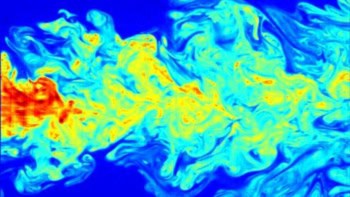
Ever since James Clerk Maxwell dreamt up his demon nearly 150 years ago, physicists have had a lot of fun in trying to create this mischievous fiend. The latest attempt comes from a group of researchers at the University of Oregon who have created a laser array that brings order to a bunch of ultracold atoms, much like the hypothetical demon.
Maxwell imagined his demon as a miniscule creature who can control a trapdoor in a gas to segregate hot atoms from cold. He proposed this ‘thought experiment’ because it seemed to offer a simple way of violating the second law of thermodynamics by reducing entropy in the system without expending any energy.
Demonic insight
The general consensus amongst physicists is that the demon – as Maxwell had envisaged – would be impossible to realize. Largely because, in sorting the atoms, the demon must open and close the trapdoor at precisely the right times; to do this he would need to know the position and velocity of every atom at any given moment. “In a sense, then, by having such knowledge, the demon has already transferred the entropy of the gas into his brain,” said Daniel Steck, one of the researchers at the University of Oregon.
Now, dragging the demon into the 21st century, Stein and his colleagues readdress the riddle using the modern techniques of ultracold atom research. The researchers created their demon using a laser array, which was focussed on a group of ultracold Rb-87 atoms. Lasers were tuned so their beams of light pushed differently on different atoms depending on their spin.
To begin with, all the atoms are in a state where the first laser beam doesn’t repel them, so they can pass through the beam with ease. However, once they cross this beam they are struck by a second laser beam, which alters their spin state and makes them repellent to the first laser. The result is that atoms become trapped on the farside of the laser.
Problem solved?
“Our one-way barrier acts to put all the atoms into a subsection of the original container. In essence this is the same as the original demon, since the point is that the demon can apparently reduce the entropy of the gas,” Steck told physicsworld.com.
This result is the latest in a line of research, pioneered over the last two years by Mark Raizen, and independently by Andreas Ruschhaupt and Gonzalo Muga. The paper was published this week on the arXiv preprint server.
“The original motivation was to come up with the analog of a diode for cold atoms, said Steck. “This could yield a nice way to direct the motion of atoms, for example, to shuttle atoms around on a chip-sized trap for potential realizations of quantum computers.”
Despite the claims of Steck and colleagues, other researchers are still not fully convinced by this latest research.
“The connection to Maxwell’s demon is reasonable, but should not be that surprising, since cooling in cold atom experiments already relies on using optical manipulation to transfer entropy from the atoms of interest to other parts of the system,” said Jonathon Keeling, a condensed matter researcher at the University of Cambridge.



